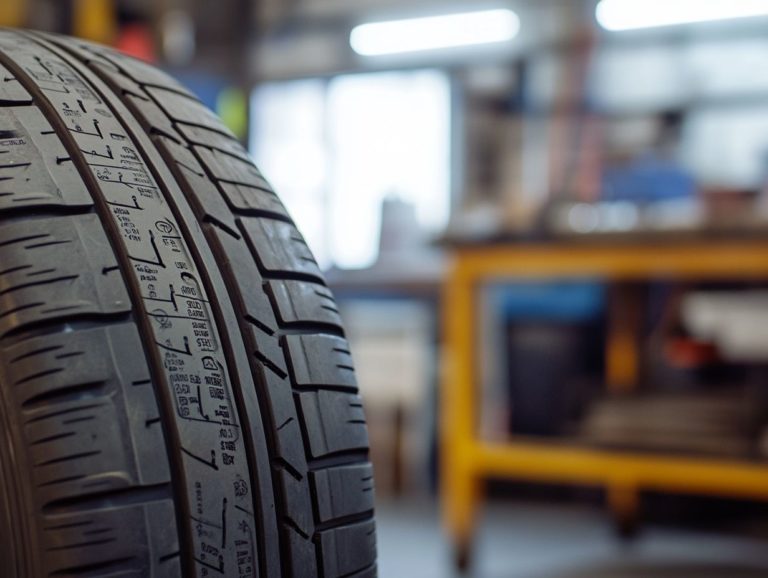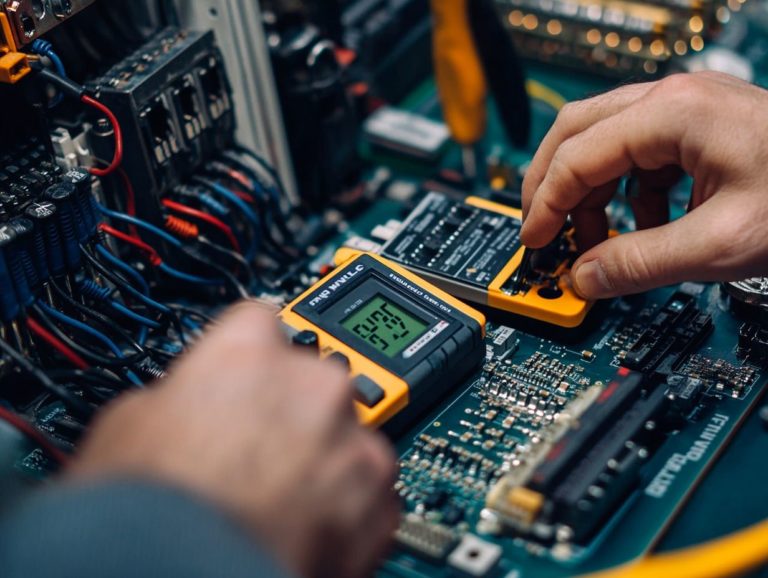Understanding Your Car’s Fluid Levels
Maintaining the right fluid levels in your car is essential for both its longevity and optimal performance. This guide will walk you through the vital fluids that ensure your vehicle operates smoothly, beginning with engine oil and its critical function in lubrication and protection.
You ll learn how to effectively monitor and refill coolant to prevent engine overheating. You will also gain insights into transmission fluid for seamless gear shifts, along with other important fluids such as brake fluid and power steering fluid.
You’ll learn how to keep your car in top shape.
Contents
- Key Takeaways:
- Checking and Maintaining Engine Oil
- Monitoring and Refilling Coolant
- Transmission Fluid: Importance and Maintenance
- Other Essential Car Fluids
- Frequently Asked Questions
- What are the important fluid levels to check in my car?
- How often should I check my car’s fluid levels?
- What happens if I neglect to check my car’s fluid levels?
- How can I tell if my car’s fluid levels are low?
- Can I check and refill my car’s fluid levels myself?
- Are there any additional tips for maintaining proper fluid levels in my car?
Key Takeaways:

- Regularly checking and maintaining your car’s fluid levels is crucial for its overall health and performance.
- Engine oil should be checked and changed regularly according to your car’s manual. This ensures proper lubrication and prevents engine damage.
- Keep a close watch on your coolant levels to avoid the nightmare of engine overheating and expensive repairs!
Why are Car Fluid Levels Important?
Understanding the importance of car fluid levels is essential for every automobile driver. Proper fluid maintenance not only ensures safe driving but also optimizes performance. Additionally, understanding your car’s warning lights can help you monitor these critical fluids like engine oil, coolant, power steering fluid, brake fluid, and transmission fluid, ensuring your vehicle runs efficiently and reliably.
Neglecting regular checks may lead to mechanical damage and costly repairs, especially with engine components vital for performance.
Monitoring these essential fluids isn’t just a precaution it’s a necessity for anyone who values safety and reliability.
Failing to maintain adequate engine oil levels can increase friction and lead to overheating, while low coolant levels can cause severe engine damage. The significance of power steering fluid cannot be overstated; insufficient levels can make steering difficult, directly impacting your control over the vehicle.
Brake fluid is crucial for the hydraulic braking system, and if neglected, it can result in reduced braking performance, which poses serious safety risks. Similarly, neglecting transmission fluid levels can lead to shifting issues and ultimately culminate in a costly transmission failure.
To keep your vehicle functioning smoothly, you should routinely check these fluids ideally every month or before embarking on long trips. Always consult your owner s manual for specific recommendations regarding fluid types and capacities. Your vehicle’s performance and your safety depend on it.
Checking and Maintaining Engine Oil
Checking and maintaining your engine oil is essential for regular vehicle upkeep, ensuring that your engine runs smoothly and efficiently. The dipstick the tool used to check oil levels is your best friend in this process, allowing you to easily assess oil levels.
Knowing when to add more oil can save you from potentially costly engine damage down the line. It’s important to stay alert for signs of oil leaks, as these could signal a need for immediate attention from a mechanic to prevent serious mechanical issues.
How to Check and Change Engine Oil
To check and change your engine oil effectively, begin by positioning your vehicle on a level surface and allowing the engine to cool. Use the dipstick to assess the oil level, ensuring it falls within the recommended range. If it s low, be ready to top it up before moving forward with your oil change.
Next, pull out the dipstick, wipe it clean with a lint-free cloth, and then reinsert it fully for an accurate reading. If the oil level sits below the minimum mark, carefully open the oil fill cap and pour in the appropriate type of oil, using a funnel to avoid any spills.
When it s time to change the oil, gather your necessary tools, including an oil filter wrench, and position a container beneath the oil pan to catch the old oil. Once the oil has fully drained, replace the old filter and add fresh oil, checking the level again with the dipstick.
Regular oil changes typically every 3,000 to 5,000 miles and using the manufacturer s recommended oil type will ensure your vehicle s longevity and performance. Always remember to dispose of used oil responsibly and wear gloves to keep your hands protected during this maintenance.
Monitoring and Refilling Coolant

Monitoring and replenishing coolant is vital for every vehicle owner who wishes to prevent overheating and ensure peak engine performance. The coolant, typically housed in the radiator, plays a crucial role in regulating engine temperature by absorbing excess heat. Neglecting this can lead to severe mechanical damage.
By regularly checking the coolant level and ensuring it contains sufficient antifreeze (a liquid that helps prevent your car s engine from freezing or overheating), you set the stage for maintaining your vehicle’s efficiency and longevity.
Signs of Low Coolant and How to Refill
Recognizing the signs of low coolant is crucial to prevent potential overheating issues and mechanical damage to your vehicle. Look out for common indicators such as a rising temperature gauge, visible leaks around the radiator, and any unusual odors that might suggest a coolant leak.
Recognizing these symptoms empowers you to act quickly, ensuring the longevity of your engine. To address low coolant levels, start by checking the coolant reservoir when the engine is cool. If needed, refill it with the appropriate antifreeze, following the manufacturer s specifications meticulously.
- Always use a funnel to avoid spills.
- Remember to secure the cap tightly afterward.
If the gauge continues to rise or if there are persistent leaks, seek help from a professional automotive service immediately if you notice problems. They can effectively determine and rectify any underlying issues.
Transmission Fluid: Importance and Maintenance
Transmission fluid is vital for lubricating and managing movement within your vehicle’s transmission system, ensuring seamless shifts and optimal performance. Regular maintenance of this fluid is important; neglecting it can lead to serious transmission problems.
Taking proactive care of your transmission fluid not only enhances your driving experience but also helps prevent costly repairs down the line.
How to Check and Change Transmission Fluid
Checking your transmission fluid is not just maintenance; it’s a chance to ensure your car runs smoothly! Start by locating the transmission fluid dipstick, and take a moment to evaluate the fluid’s color and level. This will help you determine whether it needs changing or if it simply requires a top-up.
The ideal transmission fluid boasts a bright red or pink hue, while a dark brown color or a burnt smell suggests it may have seen better days. To change the fluid effectively, begin by warming up the engine this makes drainage much easier. Once warmed, remove the drain plug and let the old fluid drain completely into a suitable container.
Don t forget to replace the filter if it s necessary, and refill with fresh fluid, ensuring that you choose the correct type for your specific make and model. As a general guideline, checking your transmission fluid every 30,000 to 60,000 miles is advisable to maintain optimal performance and avoid costly repairs in the future.
Other Essential Car Fluids

Beyond just engine oil and coolant, there are several other essential fluids you need to keep an eye on to ensure both your safety and your vehicle’s performance.
- Brake fluid: plays a crucial role in the braking system, making it imperative for your vehicle’s ability to stop effectively.
- Power steering fluid: contributes to smooth steering and handling, allowing you to navigate with ease.
- Windshield washer fluid: vital for maintaining visibility during unpredictable weather conditions and requires regular top-ups to stay effective.
Brake Fluid, Power Steering Fluid, and Windshield Washer Fluid
Brake fluid, power steering fluid, and windshield washer fluid are vital for your vehicle s performance. Each one plays a unique role in ensuring a safe and efficient driving experience.
Brake fluid is essential for your hydraulic brake system. Power steering fluid smooths out your steering, while windshield washer fluid keeps your view clear.
Maintaining proper levels of these fluids is crucial. Low levels can lead to poor performance and potentially dangerous situations on the road.
Regularly checking for leaks is a smart move. Even minor fluid loss can significantly compromise your safety.
To assess your vehicle, inspect the fluid reservoirs and watch for any visible leaks. Top off fluids as necessary.
When it s time to refill, consult your owner s manual for the correct type of fluid and procedures. If you notice irregularities or ongoing issues, seek professional maintenance services to keep your vehicle in peak condition and avoid expensive repairs down the line.
Frequently Asked Questions
What are the important fluid levels to check in my car?
Important fluid levels to check in your car include engine oil, coolant, brake fluid, transmission fluid, power steering fluid, and windshield washer fluid. To understand their specific roles, refer to common car fluids and their functions, as each plays a crucial role in your vehicle’s function and maintenance.
How often should I check my car’s fluid levels?

It is recommended to check fluid levels at least once a month or before long trips. If a warning light appears on your dashboard, check that fluid level immediately.
What happens if I neglect to check my car’s fluid levels?
Neglecting your car’s fluid levels can lead to serious issues like engine damage and breakdowns. Don t wait check those fluids!
How can I tell if my car’s fluid levels are low?
Look for warning lights on your dashboard or unusual noises. Address any signs of low fluid levels quickly!
Can I check and refill my car’s fluid levels myself?
Yes, most car owners can check and refill their car’s fluid levels themselves. Refer to your car’s manual for specific instructions and use the correct type of fluid. If you’re unsure, it’s best to consult a certified mechanic.
Are there any additional tips for maintaining proper fluid levels in my car?
Yes, in addition to regularly checking and refilling fluid levels, have your fluids flushed and replaced according to the manufacturer’s schedule. This helps ensure optimal performance and prevents potential issues.
Take a moment to check your fluid levels today your car will thank you!






